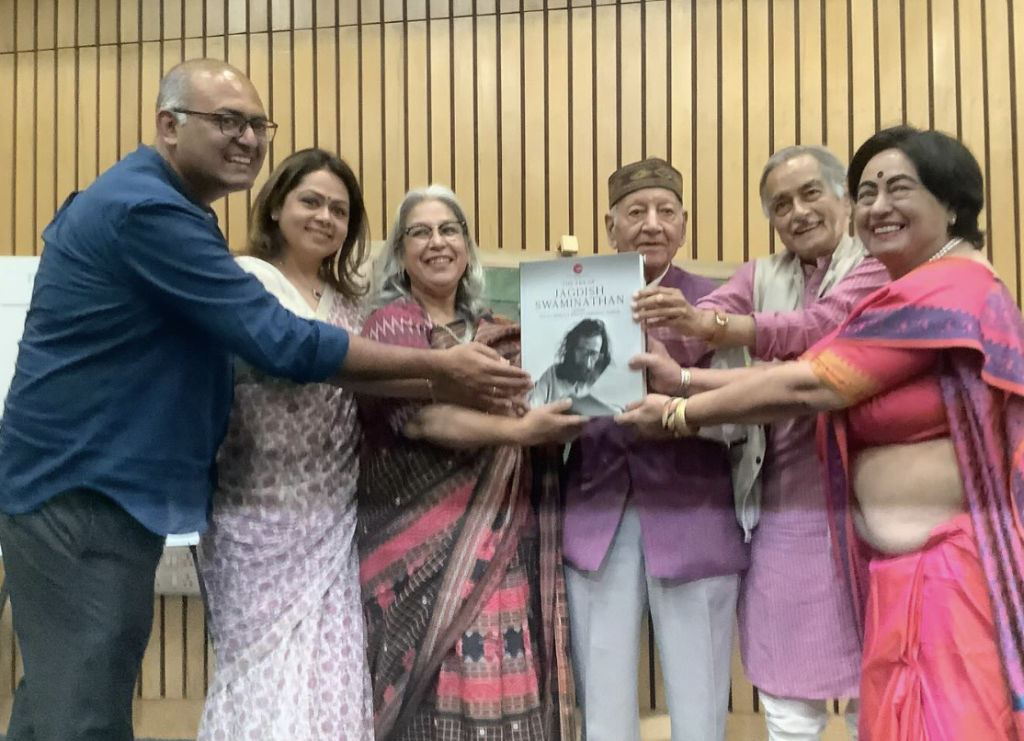Yesterday, at the India International Centre, the Dhoomimal Gallery honoured the legacy of Jagdish Swaminathan on what would have been his birthday, thirty years after his passing in 1994. The highlight of the event was the release of a new book titled “The Era Of Swaminathan,” edited by Prayag Shukla and Shruthi Lakhanpal Tandon. The book, a comprehensive compilation of Swaminathan’s writings, poetry, and art, was unveiled by the eminent artist Rajesh Mehra, a contemporary and friend of Swaminathan.
In her talk, Shruthi Lakhanpal Tandon eloquently captured the essence of Swaminathan’s influence on Indian art. She spoke on behalf of her co-editor Prayag Shukla and herself, underscoring the significance of Swaminathan’s contributions.
“Jagdish Swaminathan,” she began, “represents an era in the world of Indian art characterised by a collective search for identity, free from historical and traditional expectations and unburdened by Western influence.” She highlighted how Swaminathan and his peers established Indian art as a unique and distinct entity, flourishing alongside music, dance, and theater. This era was marked by the artists’ engagement in travel, dialogue, mentorship, and writing, recognising Indian tribal and folk art as on par with contemporary art.
Tandon recounted how in Bhopal, Madhya Pradesh, the entire art community and the government rallied to help Swaminathan create a museum, demonstrating the collaborative spirit of the time. She emphasised the importance of bringing together Swaminathan’s essays, which span from the 1960s to the 1990s, into one concise publication. These writings, noted for their depth of perception, thought, and passion, had previously been scattered and difficult to access.
The research process for the book involved extensive interviews with Swaminathan’s contemporaries and friends, including Rajesh Mehra in Delhi, Ghulam Mohammed Sheikh and Jyoti Bhatt in Baroda, and others in Jorhat and Bhopal. Notably, they discovered 17 unpublished drawings by Swaminathan from a visit to Narayanpur, which are now included in the book. Tandon also mentioned the recovery of rare black-and-white photographs from various sources, including official photographer Prakash Hatwal and Swaminathan’s family. These images serve as visual timekeepers, capturing the vibrant colours of the 1960s and 1970s.
Among the book’s treasures are lesser-known interviews and poems by Swaminathan, such as “Sanchi,” “Bhopal Ka Tal,” and a piece on his favorite musician, Kumar Gandharva. The book is divided into sections that reflect the multifaceted aspects of Swaminathan’s personality, including his essays, articles, solo show catalogs, and poems written about him by Hindi poets, translated into English for the first time.
Swaminathan’s impact extended beyond his art; he mentored a generation of younger artists, whose thoughts and experiences are also captured in the book. Essays written after his passing further illustrate his enduring influence. Tandon acknowledged the crucial support of Uday Jain, director of the Dhoomimal Gallery, whose dedication to preserving the gallery’s relationship with Swaminathan was instrumental in the book’s realisation. Jain understood the importance of documenting Swaminathan’s words and works, advocating for the power of physical meetings and the evocative nature of black-and-white photographs.
In closing, Tandon remarked, “For a person as prolific as Swaminathan, it is perhaps not possible for a single book to encapsulate his enormous contribution to Indian art, both contemporary and tribal, as well as his thinking and writing on art, poetry, music, and the performing arts. This publication is our sincere attempt to give the reader just a small glimpse into a mind of rare intelligence, ingenuity, integrity, and generosity.”
The event was a poignant reminder of Jagdish Swaminathan’s incredible mark on Indian art, celebrating his legacy and ensuring his contributions continue to inspire future generations.
Feature Image Courtesy: Dhoomimal Gallery
Akhilesh witnessed Husain, Raza & Swaminathan, and shines on his own






